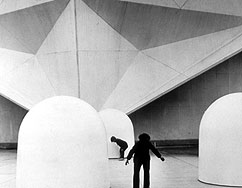 |
| Photo courtesy: E.A.T. |
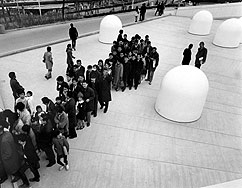 |
| Photo courtesy: E.A.T. |
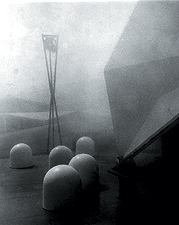 |
| Photo courtesy: E.A.T. |
 |
《ペプシ館》1970年 大阪/日本万国博覧会
Photo courtesy: E.A.T.
|
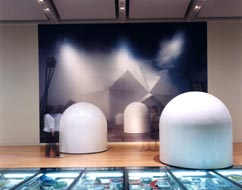 |
|
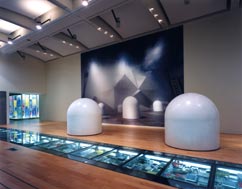 |
| Photo: TAKAYAMA Kozo |
|
|
Breer was the first person to bring E.A.T. to the "Expo '70 Osaka" Pepsi Pavilion project. Along with Kl_ver, Rauschenberg, Whitman, and Tudor he played an important role in determining the Pavilion's basic design. Originally his Floats were to be exhibited in the Clam Room inside the Pavilion, but ultimately they were placed in the concrete plaza near the entrance. True to their name, the Floats floated like hovercrafts, setting off fog created by Fujiko Nakaya. At first glance the work looks like a stationary inorganic abstract sculpture, but, in fact, it is being moved by onboard motors (at 6 inches per minute). Unsuspecting viewers were often caught off guard by Floats suddenly appearing beside them. The Floats also sometimes emitted quiet sounds (of birds singing, of sawing, or voices talking about a beautiful landscape).
The idea came to Breer during a conversation at his home with David Thomas, vice-president of the International Division of PepsiCo. Thomas compared the floats, which give the impression of being immobile, to the rocks in the garden at Ryoanji temple and suggested that Breer use them to create a Zen meditation garden. Like Nakaya's fog, Breer's Floats were conceived from the outset both as part of the environment of the Pavilion and as constituting their own microcosm. Moving almost undetectably together with the fog, they created spatial relationships within the Pavilion, transforming the interactive environment that enveloped the viewers. (*)
Today Breer is known for his "moving sculptures" and as an animator. He relocated to Paris as a painter in 1949, and there became more interested in the way images change during the process of production rather than in the finished work itself. Breer says the shift was inspired by works like Matisse's Large Reclining Nude (1935), which manage to record that process. In animated films the changes from one frame to the next are negligible, but add up to something much larger. It is this same principle that informs Breer's moving sculptures.
The small "floats" that preceded these were meant for indoor use and were powered by a small motor and flashlight batteries. But for these larger ones, Breer worked with electrical engineer John Ride to use golf cart technology. To insure safety, they were designed to change direction whenever they collided with a wall or a person. [KAMIKANDA Kei]
* -- Calvin Tomkins, "Outside Art," in Pavilion by Experiments in Art and Technology, eds. Billy Kl_ver, Julie Martin, and Barbara Rose (New York: E. P. Dutton & Co., Inc., 1972), 106, 108; Norma Loewen, Experiments in Art and Technology: A Descriptive History of the Organization (Ph.D. diss., New York University 1975), 280.
|
